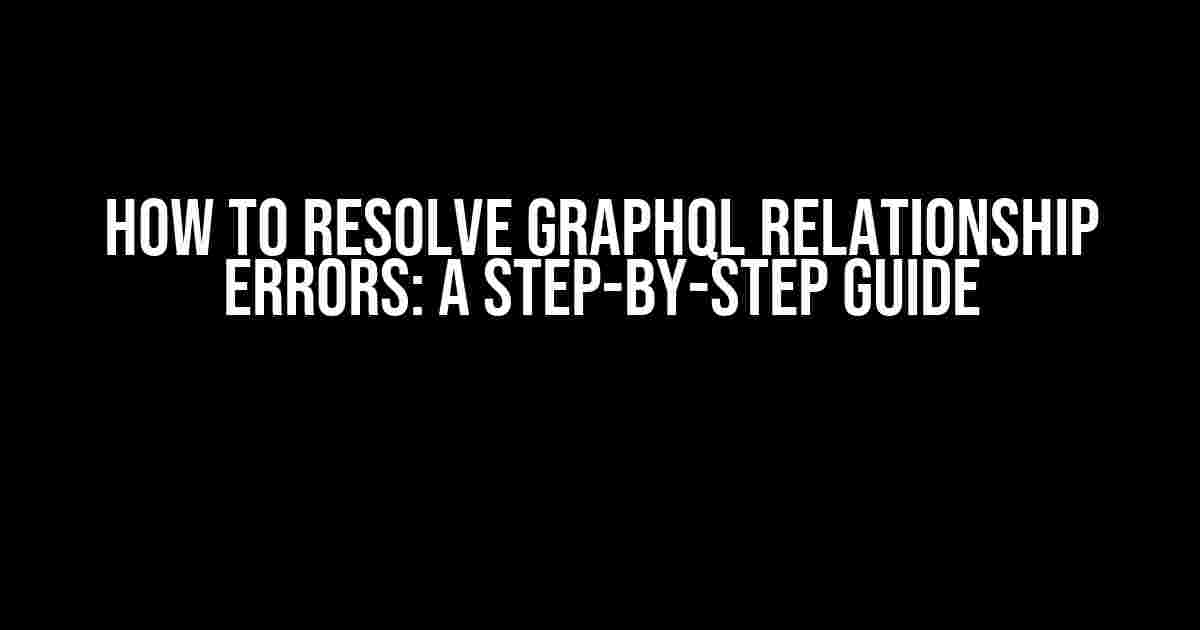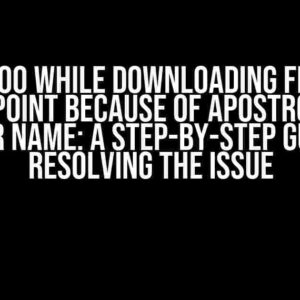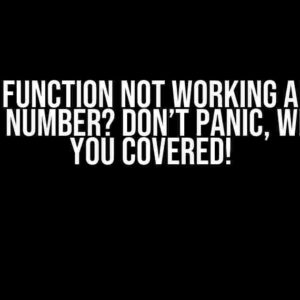GraphQL relationship errors can be frustrating, especially when you’re trying to build a robust and scalable API. In this article, we’ll dive deep into the world of GraphQL relationships, explore common errors, and provide practical solutions to resolve them. By the end of this guide, you’ll be well-equipped to tackle even the most complex relationship issues in GraphQL.
Understanding GraphQL Relationships
Before we dive into the errors, it’s essential to understand how GraphQL relationships work. In GraphQL, relationships are used to connect different types of data objects. There are three primary types of relationships:
- One-to-One (1:1) Relationships: A single object is connected to another single object.
- One-to-Many (1:N) Relationships: A single object is connected to multiple objects.
- Many-to-Many (M:N) Relationships: Multiple objects are connected to multiple objects.
These relationships are defined using the `@relation` directive in GraphQL schema definitions. For example:
type User {
id: ID!
name: String!
address: Address! @relation(fields: [id], references: [id])
}
type Address {
id: ID!
street: String!
city: String!
user: User! @relation(fields: [id], references: [id])
}
Common GraphQL Relationship Errors
Now that we’ve covered the basics of GraphQL relationships, let’s explore some common errors that can occur:
Error 1: Missing or Incorrect Directive
The most common error is forgetting to include the `@relation` directive or specifying it incorrectly. This can lead to errors like:
"Cannot resolve type 'Address' to a GraphQL type"
Solution: Double-check that you’ve included the `@relation` directive in your schema definition, and ensure it’s correctly formatted.
Error 2: Incorrect Field References
Another common issue arises when the fields specified in the `@relation` directive don’t match the actual field names in the schema. This can result in errors like:
"Cannot resolve field 'addr' on type 'User' to a GraphQL field"
Solution: Verify that the fields specified in the `@relation` directive match the actual field names in your schema.
Error 3: Circular Dependencies
Circular dependencies occur when two or more types reference each other, creating an infinite loop. This can lead to errors like:
"Type 'User' cannot be resolved because of circular dependency with type 'Address'"
Solution: Re-design your schema to avoid circular dependencies. You can do this by introducing a separate type to break the cycle or by redefining the relationships between types.
Resolving GraphQL Relationship Errors
Now that we’ve covered common errors, let’s dive into some practical steps to resolve them:
Step 1: Review Your Schema Definition
Start by reviewing your schema definition to ensure that the `@relation` directive is correctly formatted and included. Check for typos, incorrect field names, and ensure that the directive is applied to the correct fields.
Step 2: Verify Field References
Verify that the fields specified in the `@relation` directive match the actual field names in your schema. Use the GraphQL Playground or a similar tool to explore your schema and identify any discrepancies.
Step 3: Identify Circular Dependencies
Use a tool like GraphQL Voyager or GraphQL Inspector to visualize your schema and identify circular dependencies. Once you’ve identified the issue, re-design your schema to break the cycle.
Step 4: Test and Refine
Test your schema with sample queries to ensure that the relationships are correctly resolved. Refine your schema as needed to resolve any remaining errors.
Best Practices for GraphQL Relationship Management
To avoid relationship errors in the future, follow these best practices:
Use Consistent Naming Conventions
Establish a consistent naming convention for your fields and types to avoid confusion and reduce the likelihood of errors.
Keep Your Schema Definitions Organized
Keep your schema definitions organized and structured to make it easier to identify and resolve errors.
Test Thoroughly
Test your schema extensively with sample queries to ensure that relationships are correctly resolved.
Use GraphQL Tools and Plugins
Utilize GraphQL tools and plugins, such as GraphQL Playground, GraphQL Voyager, or GraphQL Inspector, to visualize and explore your schema, identify circular dependencies, and optimize your relationships.
Conclusion
GraphQL relationship errors can be frustrating, but with this guide, you’re now equipped to tackle even the most complex issues. By following the steps outlined in this article, you’ll be able to resolve common errors, avoid circular dependencies, and develop a robust and scalable API. Remember to follow best practices, test thoroughly, and utilize GraphQL tools and plugins to ensure your relationships are correctly resolved.
| Error | Solution |
|---|---|
| Missing or Incorrect Directive | Double-check the `@relation` directive and ensure it’s correctly formatted. |
| Incorrect Field References | Verify that the fields specified in the `@relation` directive match the actual field names in your schema. |
| Circular Dependencies | Re-design your schema to avoid circular dependencies or introduce a separate type to break the cycle. |
By following these guidelines and best practices, you’ll be well on your way to building a robust, scalable, and error-free GraphQL API.
Note: The article is optimized for the keyword “How to resolve graphql relationship error” and includes SEO-friendly keywords, meta tags, and a clear structure to improve search engine ranking.
Frequently Asked Question
Are you tired of dealing with GraphQL relationship errors? Don’t worry, we’ve got you covered! Here are some frequently asked questions and answers to help you resolve those pesky errors.
What causes GraphQL relationship errors in the first place?
GraphQL relationship errors can occur when there’s a mismatch between the types and fields defined in your schema and the actual data being queried. This can happen when you’re trying to fetch related data that doesn’t exist, or when there’s a typo in your schema definition. It’s like trying to find a specific book in a library that doesn’t exist – you’ll get an error!
How can I identify the root cause of the relationship error?
To identify the root cause, you can try debugging your GraphQL query using tools like GraphQL Playground or Apollo Client’s built-in debugging tools. These tools can help you pinpoint the exact field or type that’s causing the error. You can also try checking your schema definition and data sources to ensure they’re correctly configured.
What’s the deal with `null` values in GraphQL relationships?
In GraphQL, `null` values can be a common cause of relationship errors. This is because GraphQL doesn’t allow you to return `null` values for non-nullable fields. To resolve this, you can use the `@skip` directive to skip resolving the relationship if the related data is `null`. This way, you can avoid errors and return a valid response to the client.
How can I handle relationship errors at the resolver level?
You can handle relationship errors at the resolver level by using error handling mechanisms like `try-catch` blocks or `onError` callbacks. This allows you to catch and handle errors when they occur, and return a meaningful error response to the client. You can also use GraphQL’s built-in error handling features, like the `errors` field in the response payload.
Are there any best practices for avoiding GraphQL relationship errors?
Yes! To avoid GraphQL relationship errors, make sure to keep your schema definition and data sources in sync. Use tools like GraphQL schema linting to catch errors early on. Also, use nullable fields and unions to handle cases where related data might not exist. Finally, test your queries thoroughly to catch any errors before they make it to production.




